I’ve had a number of people ask me the exact same thing after they learned I had recently received my first silencer. “Hey Foghorn, doesn’t a silencer slow down the bullet?” And to be honest, I had no idea. But I had a silencer, a chronograph and R loaded onto my computer and I was determined to find out.
While I was at AAC’s headquarters last year I learned about this idea that a silencer would slow down the bullet. Turns out that its based in fact — the early silencers used a rubber gasket (or “wipe”) at the end of the can that would contact the round and slow it down. The idea was that the gasket would contain the gases for a little longer as the bullet flew downrange quieting the gun even more, but the friction wore out the gaskets quickly and proved to decrease the velocity and accuracy of the rounds.
Modern silencers don’t use the wipes anymore. As AAC’s guys tell it, the silencers are machined to such precision that there isn’t much distance between the round and the baffles to begin with, and a wipe is unnecessary.
So what effect does a modern silencer have on ammunition velocity? To find out I headed out to the Bracken Range in San Antonio, Texas and set up a test.
Using the 762-SDN-6 silencer on a pair of upper receivers, I would fire 10 rounds with and without the silencer, recording the velocities for each round downrange. Then, using R I would plot those velocities and see if there was any distinct difference in the velocities observed between silenced and normal operation.
I used both 5.56 NATO and 300 BLK ammunition for this test, and while the 762-SDN-6 is indeed a 30 caliber silencer it is capable of suppressing the sound of 5.56 also — just not as well as a dedicated 5.56 can.
So what were the results?
For the 5.56 NATO ammunition there is an observed gain of about 20 feet per second with a silencer, but that gain is statistically insignificant. We’re talking about a 1-3% increase in velocity (which in the grand scheme of things is negligible), and R is telling me that the difference is more likely random sampling error than an actual difference. So, in short, nothing different.
For the 300 BLK ammunition there is no change in the velocity observed. The boxplot gets bigger for the silenced box, but it only does so because instead of firing 10 rounds like I was supposed to I fired 40 rounds. Why? Because it was a ton of fun, that’s why. Anyway, the difference in mean velocities is so small that I’m not even going to mention it. Again, statistically insignificant change in velocity.
So what’s the final word? According to what I’m seeing here a modern silencer does not change the velocity of the ammunition in any meaningful way. Sure it will throw your shots low, but that’s because the silencer is adding weight to the barrel and forcing it down. But that’s it.
[Email your firearms-related questions to “Ask Foghorn” via [email protected]. Click here to browse previous posts]

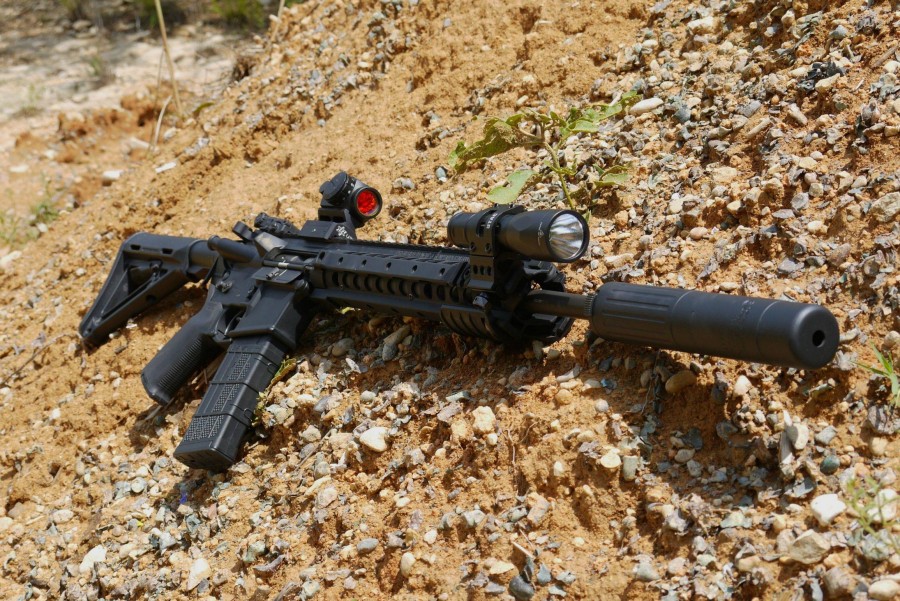
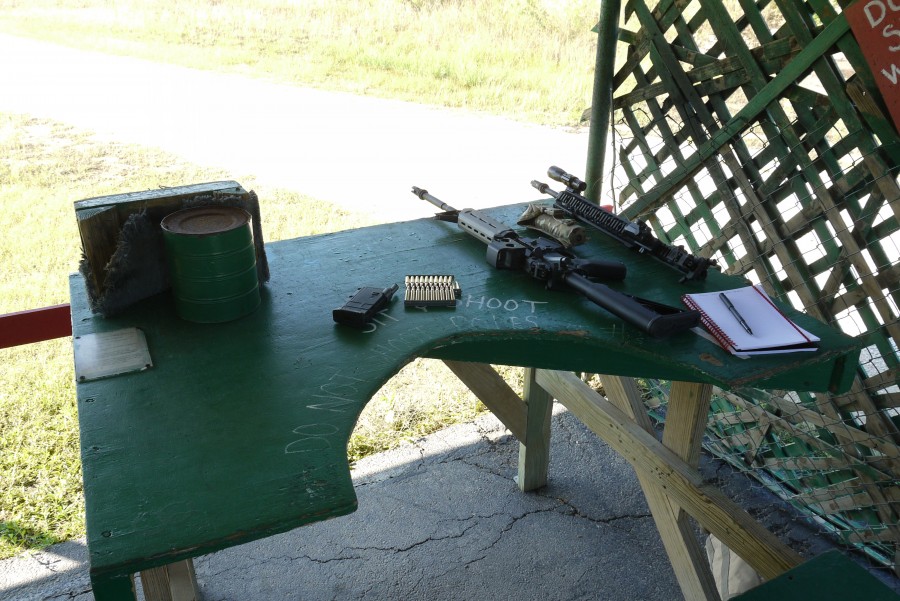
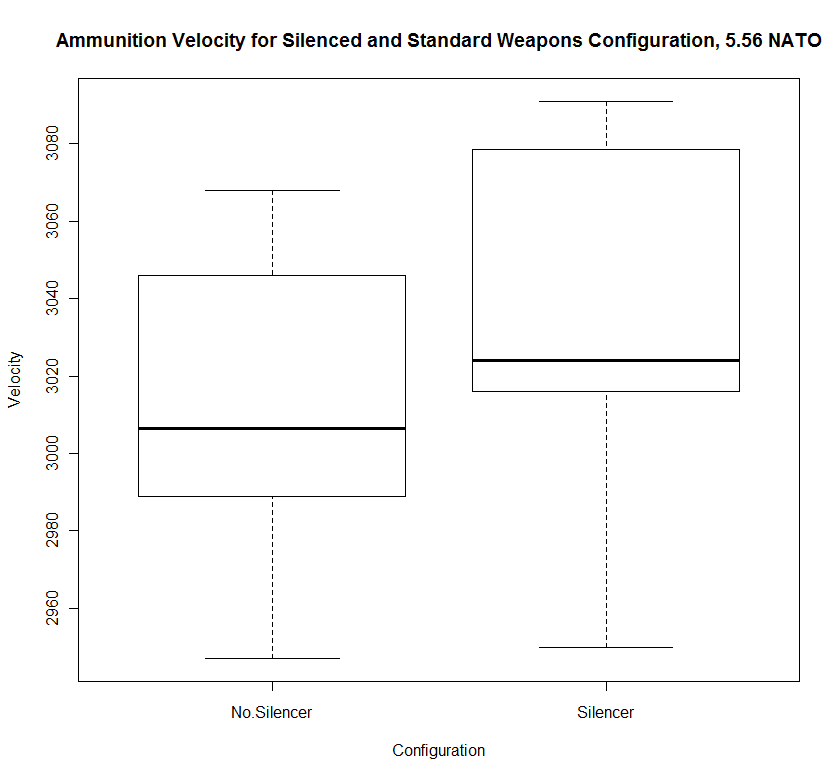
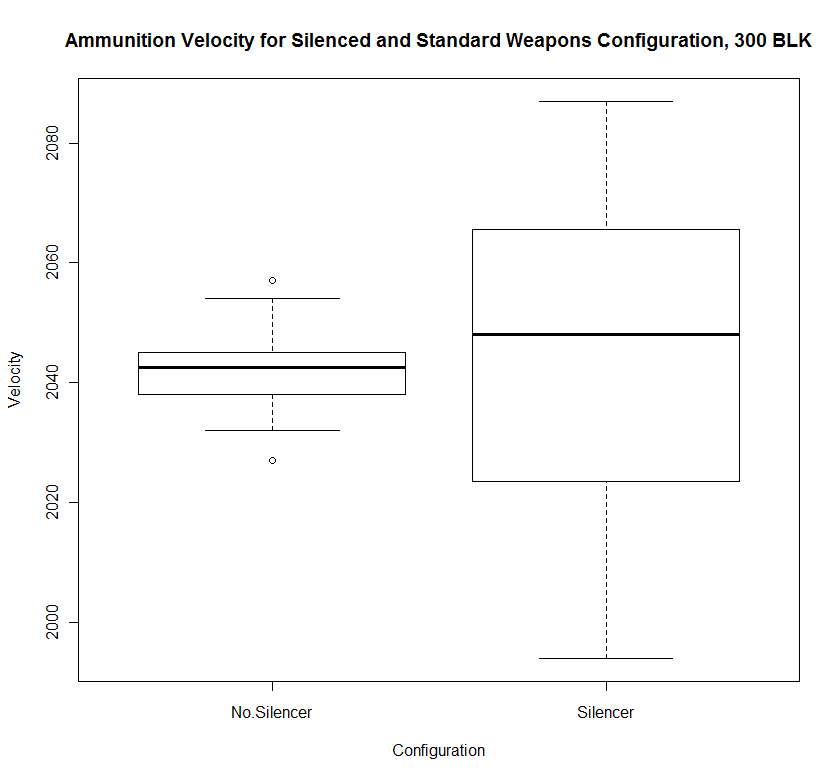
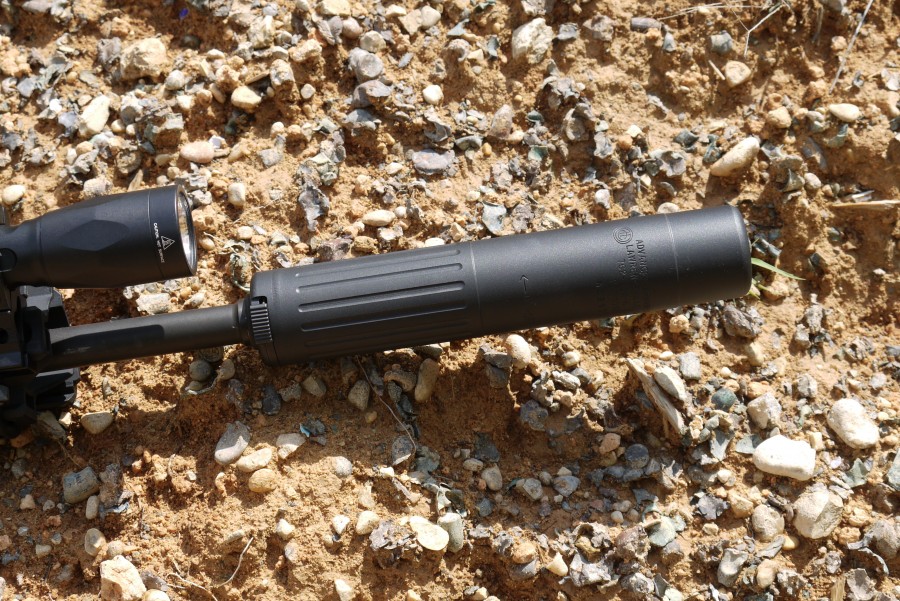

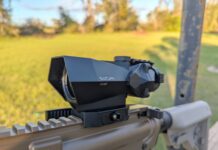

Wouldn’t it be correct to say that, in proper use of a silencer, subsonic ammunition – by definition, slower than standard ammunition – has to be used anyway?
You don’t mention in the text, but was subsonic ammunition what was used to get your figures? Based on the FPS values listed, it doesn’t look like you did. Correct me if I’m wrong, but subsonic ammunition, ideally, should be in the 700-800 FPS range, not 2400 and 3000+ as indicated in your graphs.
I mean, I see the question you were asked and the answer you’re offering. But isn’t that like asking the benefits of mid-grade or premium on engine performance over regular unleaded, and then using 120-octane avgas to derive an answer?
.300 AAC/BLK is offered in both subsonic and supersonic rounds.
I didn’t read where he stated he was using subsonic, although it’s logical to assume that he would with a suppressor.
The data displayed indicate 3000 fps which is more than twice the speed of sound. Looks like he used standard ammo and not subsonic.
In this case supersonic / subsonic ammunition doesn’t matter. If the velocity of a supersonic round would be impacted then the velocity of a subsonic would as well, and vice versa. Supersonic rounds don’t have some strange quality that makes them impervious to the laws of physics.
True, but I would think that the slowdown would be greater on a subsonic round, as the forces acting on it are of higher proportion than when acting on a supersonic round.
While the affect isn’t as pronounced with supersonic ammo, giving what appears to be a 20-40 FPS average slowdown, might be more noticeable on a round that’s moving two to four times slower to begin with – such that
20fps slowdown/2400fps base speed = 0.83% slowdown
…and, assuming you can expect a .83% percent slowdown on all your rounds
.83% * 800fps base subsonic speed = 66.4fps
800fps base subsonic speed minus 66.4fps slowdown = 733.6fps after-silencer speed
Again, probably not very noticeable to the shooter, but definitely a more pronounced effect.
Which would be true if the ammunition was slowing down. On the contrary, the ammunition appeared to be speeding up with the silencer attached. Not a statistically significant speed-up, but its there in the chart.
I get what you’re saying, and I’ll be perfectly happy to re-try with subsonic ammo later this week.
You have it backwards. The common knowledge on the silencer gun boards has always been that suppressors give you (if anything) a slight velocity *boost* due to more efficient use of the powder. So the results here are perfectly in line with what everyone reports. And yes, that trend holds true for sub sonic ammo as well: suppressor=greater average velocity.
James, your math is wrong. 20fps is .83% of 2400fps. But .83% of 800fps IS NOT 66fps. it is 6.6fps. so the first would have an after silencer of 2380 fps and the subsonic would have a speed of 793.4 fps. Keep track of the decimal points…..
I see what I did – .083 instead of .0083
Decimal points, indeed.
You’re missing the point. It’s in the spirit of being silent. It defeats the purpose of using a supressor if your ammunition creates a loud bang, breaking the sound barrier, further down range than just outside the barrel. So instead of the ammunition being slowed by the suppressor, the ammunition fired is slower
Wow, uh, no. The big point is to bring muzzle noise down to levels where the chance of hearing damage is less. Being silent is only a minor, application-specific point, and when folks want to utilize that, they use subsonic ammo. The rest of the time we use regular old range ammo with silencers/suppressors for the sake of our ears.
When was the last time the barrel was clneead to remove the fouling?With .22s they often build up a lube track from the lead deposits. If the lube track is getting heavy enough the standard and low velocity rounds may be going slow enough to not be stable. Another option is at the slower speed the bullet may pick up excess deposits or shed more weight throwing off the center of gravity.The high velocity rounds may be going fast enough and have enough pressure to not have a problem with the lube track.If it has been clneead, I would do it without the can on and see what happens. If it still tumbles break out a chrono and make sure you’re getting expected velocities. It is a mysterious problem keeps us updated. I’m interested in hearing what the final root cause is.
Sorry but I think you’re barking up the wrong tree here… if there are any barrel deposits, it would be copper, not lead, since the majority of bullets traveling down the barrel are of the jacketed variety. No lead ever comes in contact with the barrel so long as the bullet stays intact. Even a soft-nosed hunting round will leave minimal deposits if at all. Now if you’re casting your own bullets, that’s a different story, but then you aren’t propelling them to almost 3000 FPS either, unless you also have a swaging machine to jacket them.
So, they caught a cpluoe of criminals selling illegal firearms. What does this have to do with the vast majority of decent, law abiding gun owners who not only did not do anything illegal, they wouldn’t even contemplate anything like this? But then, the ATF has to point to the odd criminal to justify ts own miserable existence, and its own history in trafficking arms to the worst killers in North America the Mexican drug cartels in a patently hairbrained scheme that left at least two Federal officers and likely hundreds of innocent Mexicans dead. If anything, the entire outfit deserves to be institutionalized for mental retardation considering what it has Achieved on the whole.
and being a pedant, I would appreciate if you would edit the Headline to read “affect” instead of effect. as long as we’re talking about “final words”
Headline amended. Thanks!
Thank you!
Appreciate the data. I do have some questions about using a “silencer”.
How quiet is a 5.56 or 300 Black when using a silencer with bullets that travel faster than sound? Is there a loud crack as the bullet breaks the sound barrier?
Is it standard procedure to use rounds faster than the speed of sound or does it not make a difference?
I never wanted a ‘silencer’ as I thought you had to use subsonic bullets and felt the trade off of power would be too great. If these work with standard ammo, I would take another look.
Supersonic rounds will still be “hearing safe” with a silencer. The supersonic crack is mainly an issue downrange, so you standing behind the gun won’t have much of an issue.
But in Call Of Duty silencers only reduce damage. I mean, I’m pretty good at that game, I could be special forces or something.
*eye roll*
Damn vid-ya games
I’m pretty sure in the games they are using subsonic ammo. Though realism comes second to gameplay balance.
OK, I will type this post v-e-r-y slowly – – –
Did you notice any change in bullet group impact with and without the silencer? I have noticed a change in impact with some of my rifles with/without the flash hider and/or compensators, and wonder if a silencer changes the point of impact.
He already said: “According to what I’m seeing here a modern silencer does not change the velocity of the ammunition in any meaningful way. Sure it will throw your shots low, but that’s because the silencer is adding weight to the barrel and forcing it down.”
As a general rule, you adjust your sights based on groups fired from a rest, not offhand. That would not allow the silencer weight to force the barrel down. If he is testing it from a rest and the shots are grouping lower with the silencer than without, that represents a change in the bullet impact. If Mr. Leghorn is testing from an unsupported position, that is information I did not see in the post. I can’t tell if the rifle had a bipod, and no sandbags are visible in the photo of the bench. I would also note that this report concerned velocity, not accuracy – my question was specific to group size and location.
“I would also note that this report concerned velocity, not accuracy – my question was specific to group size and location.”
Then perhaps you could have considered asking in a less-dickish way? Since per your own admission, that wasn’t part of the initial test.
I’ll type this very slowly, to make sure you follow:
You’re right, shooting from a rest means the weight shouldn’t matter, but at the bottom of the article Nick does mention that the gun shoots low with the suppressor attached. Since the velocity is the same (and quite consistent) the bullets are following the same ballistic path once they leave the barrel. So if they’re hitting differently it’s because the can altered their course in some way before they left the gun. My guess is the can changes the harmonics of the barrel – just like shooting an old WWII rifle with and without a bayonet attached. The barrel flexes during firing and the extra weight changes the frequency. The bullets still leave the gun in a consistent way and still group just fine, but with a different point of impact. One quick adjustment to the sights and you should be as good as ever.
The verb should be “affect”, not “effect”. (I know; I’m just being picky.)
Where did you measure from when you tested it while silenced? The end of the silencer or the end of the barrel?
Same place, about 3 feet from the actual muzzle.
I doubt that the weight of a suppressor would “throw the bullets low”. Instead, it’s probably a change in barrel harmonics.
Several months ago I tested the myth that a rifle would shoot differently if you fixed bayonet: It’s true. I used my Bushmaster AR15E23, 20 inch barrel with 1:9 twist, firing two groups (one with, one without the pig-sticker) using Federal XM193 ammo. The result: “With bayonet” grouped about four inches low at 100 yards. No real change in group size. I discussed the results with several of the gray-hairs on the range, and they suggested barrel harmonics as the source of the change.
I’d say fouling is liekly, made more liekly by the can. You could have had a baffle strike and the can is causing the key holing. First step is to get the can off and clean both the can and the gun. If you can take the can down, do it and check each baffle. Check the crown on the barrel (very common source of key holing) You could spend a lot of time trying to figure out why it’s key holing, but I can almost guarantee you that once you have everything torn down, the answer will be obvious.Or you can send it to me and I’ll fix it for you
A slight (but insignificant) boost in velocity is just about right. Think of it this way- by adding the suppressor to the barrel, you’ve added barrel length: the bullet is being pushed from behind by combustion gases longer. However, since the suppressor has room for those gases to expand into, the gas pressure in it is much lower than if it were simply added inches of normal barrel, and so the boost in velocity is only slight, e.g. it’s like adding an additional amount of normal barrel a fraction of the length of the suppressor.
Another slight effect is that the bullet goes a little faster simply because the gun looks cooler with a suppressor on it and the bullet wants to live up to that coolness by improving its own performance 🙂
Adding barrel length slows a bullet down if the powder is burnt off before the bullet reaches the end of the barrel. How long before determines how much the round is slowed. Pistol ammo made with fast burning powder and made for short pistol barrels has less velocity shot from a rifle length barrel. Shooting a 9mm round loaded to be shot from a 5-inch pistol barrel is slower out of a 10+ inch rifle. The extra rifling creates drag on the round.
I agree with EJ, the rifle tries harder when you make it look cooler
In addressing subsonic with use of suppressors, H&K had an integrated silencer with their HK MP5 series. Because 9mm is a subsonic round the report from the gun being fired was suppressed to the point that the cycling of the bolt was louder than the firing. This made it ideal for close quarter hostage and counter-terrorism operations. Now with ammunition that is supersonic, the report is louder, mainly from the shockwave created by the bullet. Suppressors are not silencers and their use in the tactical sense is to muffle the report of the weapon. In longer range scenarios, since sound is measured in dBs which means the energy is an exponential loss with greater distance the distance a theroetical enemy has to be to hear and then locate the firing position is greatly reduced as opposed to a normal firing report.
Slight amendment to what I said about the noise. Blast noise is reduced, not bullet flight noise. A supersonic round makes a shockwave that is audible If you’re close as opposed to subsonic, but supersonic rounds usually have more powder behind them increasing the amount of gasses and hence more noise. For example a .22 rifle is pretty quiet comparatively when being shot next to a 30-06.
Slight correction: Most 9×19 Parabellum rounds are just slightly supersonic (1200-1400 fps). 1100 fps is the transonic threshold. The HK MP5 SD variant with the integral suppressor used small holes drilled in the barrel to slow down the bullet to subsonic velocity (approx 950 fps), and the common supression baffling followed that. This is what allowed the MP5 SD variant to shoot so quietly that the bolt cycling was more noticeable to the user than the report.
Are you using R for your graphics? Way cool
Thanks to everyone for all the great information on here over and above original post. Love the talk about velocity, supersonic vs subsonic effects and so on. Lots of information in this article and the discussions that follow.
As an armchair physics guy, I want to give my thoughts on the accuracy/velocity of sub/supersonic rounds through a silencer (sound suppressor).
I think that the way this works is fascinating and thought you might too. If you don’t care about that kind of stuff, or just don’t feel like reading a wall of text, go ahead and skip it. You won’t be missing anything.
Here we go:
The loud sound you hear when firing a weapon is the result of the sharp change in pressure when the gasses behind the bullet meet the air (and also from the pressure of the air that can’t get out of the way of a supersonic round, but forget about that part for a minute). If you can spread out that pressure change, the sound is not as loud. That’s why an approaching high pressure weather pattern doesn’t sound like a gunshot.
Modern silencers work by breaking up the initial wave front of the expanding gas. They do this by allowing the gas to escape through a simple “maze” of some sort. That could be small holes, a winding route, some kind of batting, or a combination of these things. The idea is to cause the movement of the gas to become chaotic.
The gas still expands in the suppressor, but the suppressor makes it so that some of the gas is moving slower than other parts. The leading edge of the wave front, though, is still moving at the speed of sound.
In a subsonic round, this means that the pressure wave can move faster than the bullet.
That implies two things: First, the gas behind the bullet can disperse more quickly (relative to the bullet’s movement) during the trip through the suppressor that it could with a supersonic round, meaning the force causing the acceleration will be slightly less for the subsonic than the supersonic round (remember that they bullet’s acceleration is relative to the difference in pressure between the front of the bullet and the back of the bullet).
Second, a little bit of the wave front can get ahead of the bullet in the suppressor. This will slightly disrupt the air that the bullet is travelling through, and slight change it’s trajectory (more on this in the summation).
For supersonic rounds, it’s a little different. Because the gas is travelling faster than the speed of sound, it experiences a much higher deceleration than the bullet when it hits the air. It’s like a high diver hitting the water after a long fall. The bullet does not decelerate much because of it’s weight and it’s aerodynamic design, but the gasses slow down very quickly. It’s the difference between a high diver and a frisbee hitting the water at the same speed.
This means the gas can’t outpace the bullet and it doesn’t disperse as quickly, so the force on the bullet remains high.
In reality, both effects are tiny. The bullets go a faster because they have high pressure behind them for longer. Since subsonic rounds are typically used at shorter distances, the effect on the accuracy is probably not noticeable. If you’re shooting subsonic at long range, you’re probably using a heavier bullet that will be even less affected by the small force of the wave front.
Velocity is proportional to both force and the time over which the force is applied. In the case of the subsonic rounds, the pressure drops off faster but the bullet is travelling slower so the length of time spent in the suppressor is longer. The opposite is true for the supersonic round; higher pressure, but less time to make use of it.
So all of this to say: I think a quality, modern suppressor will increase velocity in all cases. How much, and whether it more greatly effects sub or super sonic ammunition depends entirely on the combination of load, the length and type of the suppressor, and the bullet itself.
tl;dr: Barrel-end silencers extend the effective length of time the bullet is accelerating. The difference in added velocity between one combination of components and another is best determined experimentally. Subsonic bullets may experience a tiny increase in group size at long ranges.
I hate to be the guy reviving a post nearly 6 years old, but there’s a comment from a year ago and this was the first search engine result, presumably due to Foghorn’s legendary status. I suppose it’s worth pitching in my slightly different perspective on the subject. With supersonic rounds, I’ll have to agree that the velocity increase is negligible. Case closed.
Considering that I just received my first suppressor in the dead of winter, near some Great Lake effect temperatures to boot, my thoughts on the subject have strayed down a different path. I’d like to point out that the speed of sound decreases as temperature decreases. I’m sure there are other sites with different algorithms, but I’m not smart enough to make my own or say which is closest to perfect. So here’s one: https://www.weather.gov/epz/wxcalc_speedofsound
I’ve been seeing some sub zero temperatures lately, so to just pick a temp for the sake of argument, I chose 0 degrees Fahrenheit. This gives us an alleged 1,050.74 fps speed of sound. Again, based on my personal preferences, I typically shoot Hornady factory loaded ammunition. Their two 300. BLK subsonic offerings at the moment advertise muzzle velocities of 1,020 and 1,050 fps from a 16″ test barrel, presumably without a suppressor, but I’m really not certain. So without a suppressor in the equation, it seems we’re already dancing on the line here.
By all means, play with this calculator and measure your own velocities as well as decibel levels. I don’t have the time, money or warm enough gloves to do it all myself. I’d only like to point out the tight margin of error around the sound barrier you might find yourself. It sure would be nice to see some more data in cold temperatures. Please advise if you have some. If there is indeed an issue here, maybe the solution is an even slower round? Or just move South? Yeah, I’ll just move further South.
A suppressor should add a slight amount of velocity. Longer barrels add velocity (to a point). Once a bullet leaves the barrel the amount of push it still receives from that gas drops almost immediately as the gas expands in every direction and the velocity of the gas drops to be slower than the bullet.
Once a bullet leaves the barrel of a s suppressed gun, the bullet continues to go through an additional 6″ or more where it’s still receiving positive gas pressure directly from behind. While the suppressor isn’t equal to 6″ of barrel length because of the chamber decreasing pressure due to expansion, it’s more than just air.
The 5.56 showed more of a difference because the velocity is much higher to begin with. If the .300 blackout is leaving the barrel with only 2,200 fps, the suppressor decreases the velocity of gasses much quicker than a 5.56, negating the positive effect.
So if you were using big heavy bullets in a .45, you’re not seeing an increased length of a suppressor adding anything since the bullet would be going faster than gasses at almost the exact time it left the barrel. But picture a lightweight magnum, like the .22 Nolser, and the suppressor would add more velocity as the high velocity and pressure of gasses keep pushing on the bullet throughout.
Comments are closed.